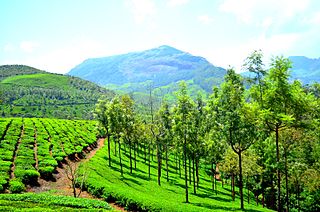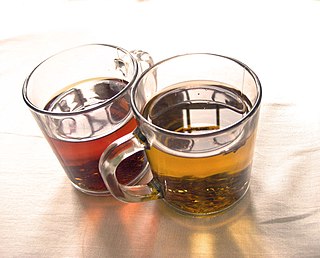
Tea is an aromatic beverage prepared by pouring hot or boiling water over cured or fresh leaves of Camellia sinensis, an evergreen shrub native to East Asia which probably originated in the borderlands of southwestern China and northern Myanmar. Tea is also made, but rarely, from the leaves of Camellia taliensis. After plain water, tea is the most widely consumed drink in the world. There are many different types of tea; some have a cooling, slightly bitter, and astringent flavour, while others have profiles that include sweet, nutty, floral, or grassy notes. Tea has a stimulating effect in humans, primarily due to its caffeine content.

Munnar is a town and hill station located in the Idukki district of the southwestern Indian state of Kerala. Munnar is situated at around 1,600 metres (5,200 ft) above mean sea level, in the Western Ghats mountain range. Munnar is also called the "Kashmir of South India" and is a popular honeymoon destination.

White tea may refer to one of several styles of tea which generally feature young or minimally processed leaves of the Camellia sinensis plant.

The Nilgiris district is one of the 38 districts in the southern Indian state of Tamil Nadu. Nilgiri is the name given to a range of mountains spread across the borders among the states of Tamil Nadu, Karnataka and Kerala. The Nilgiri Hills are part of a larger mountain chain known as the Western Ghats. Their highest point is the mountain of Doddabetta, height 2,637 m. The district is contained mainly within the Nilgiri Mountains range. The administrative headquarters is located at Ooty. The district is bounded by Coimbatore to the south, Erode to the east, and Chamarajnagar district of Karnataka and Wayanad district of Kerala to the north. As it is located at the junction of three states, namely, Tamil Nadu, Kerala, and Karnataka, significant Malayali and Kannadiga populations reside in the district. Nilgiris district is known for natural mines of Gold, which is also seen in the other parts of Nilgiri Biosphere Reserve extended in the neighbouring states of Karnataka and Kerala too.

Camellia sinensis is a species of evergreen shrub or small tree in the flowering plant family Theaceae. Its leaves, leaf buds, and stems can be used to produce tea. Common names include tea plant, tea shrub, and tea tree.

Assam tea is a black tea named after the region of its production, Assam, India. It is manufactured specifically from the plant Camellia sinensis var. assamica (Masters). The Assam tea plant is indigenous to Assam—initial efforts to plant the Chinese varieties in Assam soil did not succeed. Assam tea is now mostly grown at or near sea level and is known for its body, briskness, malty flavour, and strong, bright colour. Assam teas, or blends containing Assam tea, are often sold as "breakfast" teas. For instance, Irish breakfast tea, a maltier and stronger breakfast tea, consists of small-sized Assam tea leaves.

The history of tea spreads across multiple cultures over the span of thousands of years. With the tea plant Camellia sinensis native to East Asia and probably originating in the borderlands of southwestern China and northern Myanmar. One of the earliest accounts of tea drinking is dated back to China's Shang dynasty, in which tea was consumed as a medicinal drink. An early credible record of tea drinking dates to the 3rd century AD, in a medical text written by Chinese physician Hua Tuo. It first became known to the western world through Portuguese priests and merchants in China during the early 16th century. Drinking tea became popular in Britain during the 17th century. The British introduced commercial tea production to British India, in order to compete with the Chinese monopoly on tea by stealing green tea leaves from China, transporting them by train/road, resulting in them being fermented and thought fermented tea is the tea drunk in China. Hence the tea drank in the West is mostly fermented and not green fresh tea.

Nepali tea is a beverage made from the leaves of tea plants grown in Nepal. They are distinctive in appearance, aroma and taste, but are similar in many ways to tea produced in Darjeeling tea, perhaps because the eastern zones of Nepal have geography and topography similar to Darjeeling. Its relatively smaller production quantities mean that teas from Nepal are less well known than those from Darjeeling.

Darjeeling tea is a tea made from Camellia sinensis var. sinensis that is grown and processed in Darjeeling district or Kalimpong district in West Bengal, India. Since 2004, the term Darjeeling tea has been a registered geographical indication referring to products produced on certain estates within Darjeeling and Kalimpong. The tea leaves are processed as black tea, though some estates have expanded their product offerings to include leaves suitable for making green, white, and oolong teas.
Camellia sinensis, the source of tea leaves and buds, can be grown in much of the United States. Commercial cultivation has been tried at various times and locations since the 1700s, but tea has remained a niche crop and has never been cultivated widely in the US. As of 2020, the US mainland has one relatively large plantation with full mechanization in Charleston, South Carolina, and many small commercial tea gardens that pick tea by hand. Some growers feel that tea production is not economically viable without some mechanization, but there is evidence that unmechanized tea production is viable, albeit with lower net profit margins. Most domestically grown teas are available through mail order and online purchases.

Valparai is a Taluk and hill station in the Coimbatore district of Tamil Nadu, India. It consists of Anamalai Tiger Reserve. It is located 3,474 feet (1,059 m) above sea level on the Anaimalai Hills range of the Western Ghats. There are a total of 56 estates here. The game of football is very popular here. State level competitions are held every year. The foothill starts exactly from Monkey Falls which is at a distance of 38 kilometres (24 mi) to Valparai. The route to Valparai from the foothills consists of 40 hairpin bends. The Kerala state border town of Malakkappara is at a distance of 27 kilometres from Valparai. While major portions of the land are owned by private tea companies, large forest areas continue to be out of bounds.

India is one of the largest tea producers in the world, although over 70 percent of its tea is consumed within India itself. A number of renowned teas, such as Assam and Darjeeling, also grow exclusively in India. The Indian tea industry has grown to own many global tea brands and has evolved into one of the most technologically equipped tea industries in the world. Tea production, certification, exportation and all facets of the tea trade in India are controlled by the Tea Board of India.

India is the second largest producer of tea in the world after China, including the famous Assam tea and Darjeeling tea. Tea is the 'State Drink' of Assam. Following this the former Planning Commission Deputy Chairman, Montek Singh Ahluwalia had plans to officially recognise tea as the Indian "National Drink" in 2013. According to the ASSOCHAM report released in December 2011, India is the world's largest consumer of tea, consuming nearly 30% of global output. India is also the second-largest exporter of tea, after China.

Coffee production in India is dominated in the hill tracts of South Indian states, with Karnataka accounting for 71%, followed by Kerala with 21% and Tamil Nadu. Indian coffee is said to be the finest coffee grown in the shade rather than direct sunlight anywhere in the world. There are about 250,000 coffee growers in the country; 98% of them are small growers. As of 2009, Indian coffee made up just 4.5% of the global production. Almost 80% of Indian coffee is exported; 70% is bound for Germany, Russia, Spain, Belgium, Slovenia, United States, United Kingdom, Japan, Greece, Netherlands and France. Italy accounts for 29% of the exports. Most of the export is shipped through the Suez Canal.
Tea is a major cash crop that is grown in Kenya. Kenyan tea has been the leading major foreign exchange earner for the country.
The North Bengal Tea Industry production areas are in the North Bengal region of West Bengal state, in Eastern India. It includes tea estates and facilities in the districts of Darjeeling, Jalpaiguri, Cooch Behar, Kishanganj and North Dinajpur in West Bengal.

Mango Orange, officially spelt ‘mangorange’, is a small village in the Nilgiris district of Tamil Nadu, India. The village is dominated by tea estates. Most of the population is employed in the tea estates and there are a few schools, churches and mosques dotted around the undulating terrain.

Sri Lanka has a climate and varied elevation that allows for the production of both Camellia sinensis var. assamica and Camellia sinensis var. sinensis, with the assamica varietal holding the majority of production. Tea production is one of the main sources of foreign exchange for Sri Lanka, and accounts for 2% of GDP, contributing over US$1.3 billion in 2021 to the economy of Sri Lanka. It employs, directly or indirectly, over 1 million people, and in 1995 directly employed 215,338 on tea plantations and estates. In addition, tea planting by smallholders is the source of employment for thousands whilst it is also the main form of livelihood for tens of thousands of families. Sri Lanka is the world's fourth-largest producer of tea. In 1995, it was the world's leading exporter of tea, with 23% of the total world export, and Sri Lanka ranked second on tea export earnings in 2020 after China. The highest production of 340 million kg was recorded in 2013, while the production in 2014 was slightly reduced to 338 million kg. India has additionally guaranteed Sri Lanka a shipment of 65,000 metric tons of urea. Sri Lanka's troubled execution of an organic agriculture initiative had pushed the country perilously close to an agricultural crisis. Given the surge in global fertilizer prices, it is improbable that Sri Lanka could procure fertilizer at prevailing market rates.

Black tea is a type of tea that is more oxidized than oolong, yellow, white and green teas. Black tea is generally stronger in flavour than other teas. All five types are made from leaves of the shrub Camellia sinensis, though Camellia taliensis is also used rarely.

Kangra tea is a tea from the Kangra district in Himachal Pradesh, India. Both black tea and green tea have been produced in the Kangra Valley since the mid-19th century. Kangra tea was given the Geographical Indication status in 2005.




















